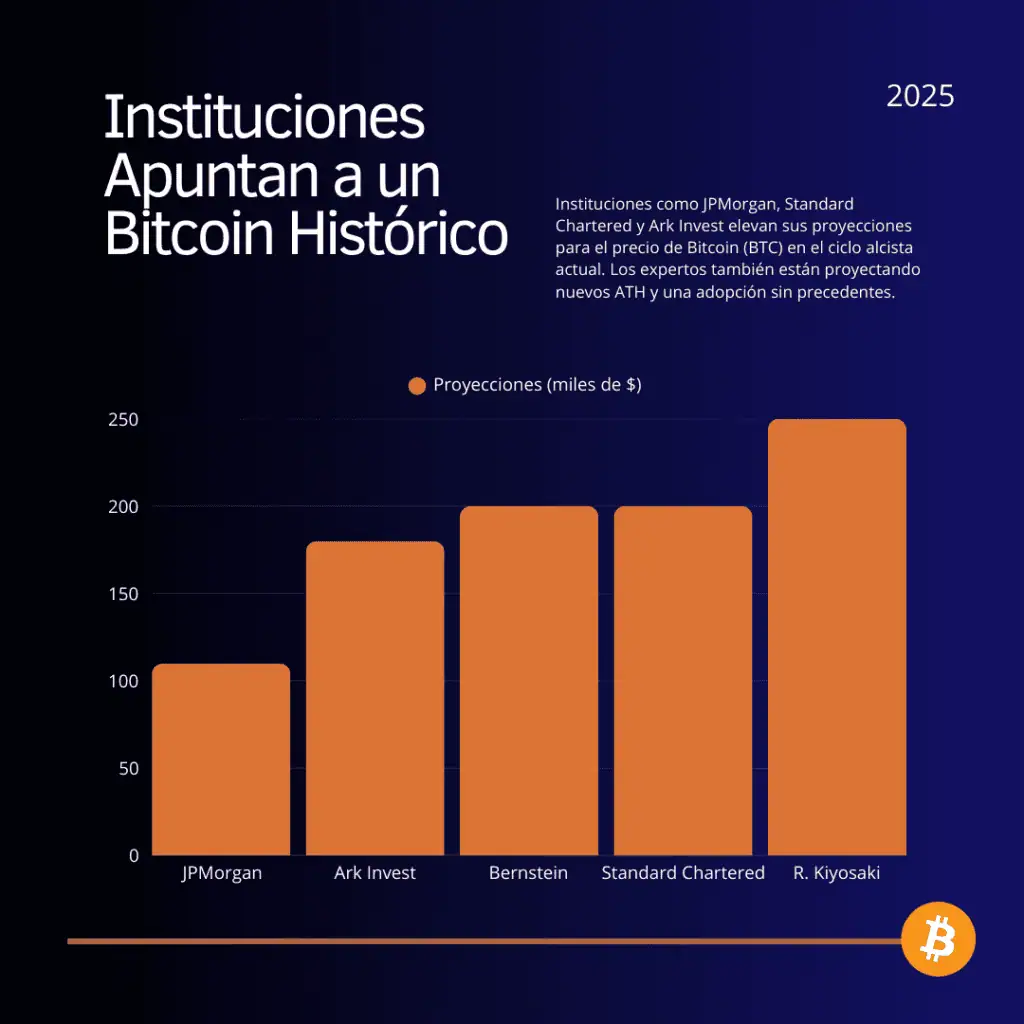
Major financial institutions have significantly raised their Bitcoin price forecasts by the end of 2025, anticipating all-time highs driven by an influx of institutional capital, favorable macroeconomic conditions, and clearer regulation.
Bitcoin's rally has captured the attention of global markets and, especially, major financial institutions, which have dramatically raised their price forecasts for the leading cryptocurrency.
While Bitcoin It is approaching its current all-time high (ATH), trading at around $107.400 per BTC., giants such as JPMorgan, Standard Chartered, Ark Invest, Bernstein and renowned investor Robert Kiyosaki agree that the bullish cycle could lead the price of the cryptocurrency between $110.000 and $250.000 dollars in the short and medium term.
Trade easily and safely with Bitcoin here.The optimism these global institutions have about Bitcoin doesn't arise in a vacuum. It's actually due to an environment of greater regulatory clarity, favorable macroeconomic conditions, and, above all, the massive influx of institutional capital through vehicles such as ETFs and corporate treasuries. In this context, we analyze the new projections, the factors behind them, and the role that regulation and the evolution of the crypto ecosystem play in Bitcoin's fate.
Bitcoin's Bullish Consensus: Historical Projections from Major Institutions
In recent months, Bitcoin price forecasts have been revised upward by some of the most important players in the global financial system.
Amber, for example, raised its estimate to $ 200.000 dollars by the end of this year, with the possibility of reaching up to $250.000 if institutional demand continues to grow. Standard Chartered, for its part, has surprised the market by adjust its previous projection of $120.000 to $200.000 by year-end, arguing that the rise of Bitcoin ETFs and massive institutional inflows will be key catalysts for the price.
Ark Investment, known for its long-term vision, places its base case at around $180.000 per BTC by 2025 and $1 million by 2030, but even in the worst-case scenario it foresees a floor of $300.000 by the end of the decade. Robert Kiyosaki, author of “Rich Dad Poor Dad,” has been even bolder, predicting that Bitcoin could reach $250.000 before the end of 2025, citing the possibility of the United States creating a strategic Bitcoin reserve as a deciding factor.
Finally, JPMorgan, which has traditionally been more conservative, has reversed its stance and now expects Bitcoin to outperform other assets for the remainder of 2025, driven by institutional appetite. This bullish consensus marks a milestone, with so many major institutions agreeing on such an optimistic scenario for the cryptocurrency.

Institutional entry: The engine behind the new cycle
One of the factors most mentioned by analysts of these global institutions is the growing inflow of institutional capital, which has transformed the Bitcoin market in recent years. The approval and success of spot Bitcoin ETFs in the United States has been a turning point, allowing pension funds, insurers, and large asset managers to gain exposure to the cryptocurrency in a regulated and transparent manner.
Furthermore, the adoption of Bitcoin as a treasury reserve by corporations and, potentially, central banks, adds a new dimension to demand. Ark Invest highlights that Bitcoin's role as "digital gold" and a safe haven against inflation in emerging markets reinforces its appeal to large investors.
YOUR SAFE DOOR TO THE CRYPTO WORLD IS HEREIn short, the institutionalization of the Bitcoin market is redefining its dynamics and elevating its profile as a strategic asset.
Macroeconomic conditions and regulatory clarity: An increasingly favorable environment
Institutional optimism regarding Bitcoin cannot be understood without considering the current macroeconomic and regulatory context. On the one hand, persistent inflation and doubts about the soundness of fiat currencies have driven the search for alternative and devaluation-resistant assets, like Bitcoin. On the other hand, greater regulatory clarity in the United States and Europe has reduced the legal uncertainty that historically weighed on the sector.
Experts emphasize that Bitcoin's analogy with gold, following the introduction of spot ETFs, is relevant, considering that the influx of institutional money into a regulated environment can trigger exponential price movements. Furthermore, the possibility of central banks including Bitcoin in their foreign exchange reserves, following the example of some emerging countries, could open up a new source of sovereign demand. The adoption of Bitcoin as a reserve asset by states like New Hampshire is also gaining ground, reinforcing the perception of the cryptocurrency as a legitimate asset and raising bullish projections.
In this sense, the convergence of macroeconomic and regulatory factors is creating fertile ground for Bitcoin's sustained growth in the market.

Cryptocurrency Technical Analysis Course
Medium levelIn this training we have Iván González, a professional expert in investments and cryptocurrencies, to teach you how the market works and how prices affect the behavior of investors.
The crypto ecosystem evolves: From speculation to financial maturity
But the current Bitcoin rally is not only a response to external factors, but also to the internal evolution of the crypto ecosystem. The market infrastructure is currently much more robust, With institutional custodians, regulated platforms, and sophisticated financial products that facilitate the participation of large players. The transparency and traceability of transactions, along with Bitcoin's integration into traditional investment strategies, have reduced the perception of risk and volatility and consolidated the cryptocurrency as a pillar of the emerging digital financial system.
Institutions emphasize that, in addition to its function as a store of value, Bitcoin is being used in decentralized financial services, expanding its use cases and systemic relevance. For its part, The “Bitcoin as a safe haven” narrative has also strengthened globally., which has driven its adoption at the retail and state levels.
BUY BITCOIN WITH CONFIDENCE AT BIT2MEIn conclusion, current projections from major financial institutions reflect a paradigm shift, with Bitcoin now viewed as a strategic asset, driven by institutional entry, a favorable macroeconomic environment, and the maturity of the crypto ecosystem.
While the future is uncertain, the bullish consensus of these institutions suggests that Bitcoin's potential is far from exhausted, and that the current cycle could mark a turning point in the history of global finance.
Investing in cryptoassets is not fully regulated, may not be suitable for retail investors due to high volatility and there is a risk of losing all invested amounts.



